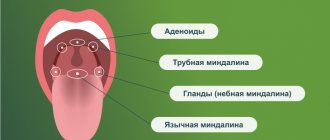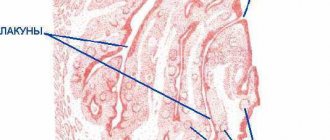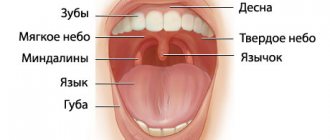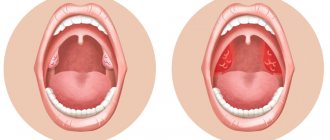Normal condition of tonsils
Tonsils are collections of lymphoid tissue located in the nasopharynx and oral cavity. Tonsils perform protective and hematopoietic functions, participate in the development of immunity - they are the first line defense mechanism against inhaled foreign pathogens. The full immunological role of the tonsils still remains unclear.
Together with other lymphoid formations of the nasopharynx, the tonsils form the pharyngeal lymphatic ring
The tonsils serve as a local immune organ, a kind of barrier against bacteria and viruses that enter the pharynx during the acts of breathing and swallowing.
Tonsils are divided into:
- paired: palatine - in the recess between the soft palate and the tongue (first and second tonsils).
- tubal - in the area of the pharyngeal opening of the auditory tube (fifth and sixth tonsils)
- pharyngeal (nasopharyngeal) - in the area of the fornix and the back of the pharyngeal wall (third tonsil, Luschka’s tonsil). Pathological enlargement of this particular tonsil is called adenoids
1.General information
Hypertrophy means an abnormal or pathological increase in the size of an organ, structure, or tissue. This concept should be clearly distinguished from terms (and the phenomena they denote) such as hyperplasia, tumor or edema.
Hyperplasia, for example, is the rapid growth of tissue due to a hormone-mediated increase in the number of healthy cells typical of a given tissue; the tumor process is characterized by a local increase in the number of cells with certain abnormalities and, finally, edema is an excessive accumulation of fluid in the cells or intercellular space.
In contrast to the above, hypertrophy is an increase not in the number of cells, but in their size - with a relatively normal quantity for a given organ - and is considered as a response to certain factors, conditions, influences.
Further, the tonsils (medical lat. “tonsilla”, incorrectly “tonsils”) are a group of glandular formations from lymphoid tissue, collectively making up the so-called. lymphadenoid pharyngeal ring and perform mainly the role of an immune barrier at the entrance to the respiratory and digestive tracts, in close proximity to the brain and sensory organs - in an area where many blood vessels, nerve tracts, lymph nodes and ducts are concentrated. In other words, the presence of the pharyngeal ring here as an outpost of the immune system is completely understandable; however, the tonsils also perform other functions that have not yet been studied enough or are completely unknown.
The most significant is a pair of relatively large palatine tonsils located on either side of the entrance to the laryngopharynx.
Tonsil hypertrophy is common in the general population with an estimated incidence of 5-10 to 40 percent. The vast majority of primary patients with this diagnosis are children and, less often, adolescents. Hypertrophic enlargement of the tonsils, which develops in adulthood, is sporadically rare.
A must read! Help with treatment and hospitalization!
Adenoids treated or removed
The most common pathology in children is enlargement of the nasopharyngeal tonsil (adenoid vegetations, adenoids). According to various authors, the presence of adenoids is noted in children under 14 years of age from 5 to 45% of cases .
adenoids
Adenoids are located in the vault of the nasopharynx, where the nasal cavity ends, serving as a natural filter that prevents viral and bacterial agents from entering the lower parts of the respiratory system - the trachea and bronchi. In children, during the inflammatory process in the adenoids (local fight against viral or microbial agents in the tissue of the nasopharyngeal tonsil), difficulty in nasal breathing may be observed due to the fact that the tissue closes the lumen of the nasal cavity at the back, thereby interfering with the normal passage of air, the presence of mucous discharge in the anterior parts of the nasal cavity, snoring. Children experience a “choking” type cough due to secretions getting from the nasopharynx onto the vocal cords.
Cough is not always associated with adenoiditis (inflammation of the adenoids). Often, a cough is associated with one or another problem in the lower parts of the respiratory system (tracheitis, bronchitis, pneumonia, childhood infections). To exclude this pathology, the child must be consulted with a pediatrician, who will perform auscultation (listen to organ sounds), giving a conclusion about the presence or absence of pathology.
Due to the specific location of the adenoids, it is impossible to apply ointment, apply sprays, or use rinses; because of this, adenoids take a relatively long time to be treated.
2. Reasons
The connection between hypertrophy of the tonsils and frequent acute respiratory viral infections, tonsillitis, laryngitis and other infectious and inflammatory diseases of the ENT organs has been reliably established. In addition, many sources indicate a higher frequency of such hypertrophies in children with weakened immunity, regardless of the reasons. Finally, a combination of hypertrophied tonsils with adenoids is constantly encountered - a hyperplastic growth of another tonsil, the nasopharyngeal; according to a number of experts, this indicates the commonality of hyperplastic and hypertrophic processes for the entire lymphadenoid ring.
Hence the conclusion is drawn about the compensatory, reactive nature of hypertrophy of the tonsils: in this case, organs that are very often and intensively used and/or cannot cope (with weakened local and general immunity) with their functions increase.
However, the etiopathogenesis of tonsil hypertrophy still remains controversial and is being actively studied by specialists in this field.
Risk factors usually include hypovitaminosis, insufficient and unbalanced nutrition, harmful environmental factors, and endocrine disorders.
Visit our Otolaryngology (ENT) page
Degrees of hypertrophy (enlargement) of adenoids
I degree - when adenoid vegetations during endoscopic examination cover less than 1/3 of the lumen of the choana (the outlet from each half of the nose into the nasopharynx)
II degree - when adenoid vegetations during endoscopic examination cover 1/2 of the lumen of the choana (the outlet from each half of the nose into the nasopharynx)
III degree - when adenoid vegetations during endoscopic examination cover the entire lumen of the choana (the outlet from each half of the nose into the nasopharynx)
Often, ENT doctors assign grade II-III - in the case when more than ½ of the lumen of the choanae is closed, but the lumen for breathing still remains, and is not completely closed.
3. Symptoms and diagnosis
It should be especially emphasized that hypertrophy itself is not an inflammatory process and should not be perceived as equivalent to tonsillitis (acute or chronic inflammation of the tonsils). Until the tonsils reach a certain size, a person may not experience any discomfort at all.
However, over time, the anomaly begins to affect itself and takes on an increasingly distinct pathological character, simultaneously causing a cascade of progressive disorders and changes in the ENT organs.
Diction is impaired, speech becomes nasal, nasal breathing becomes difficult, which may become impossible in the future. As a result, the patient is forced to constantly breathe through his mouth, which in a few years, and even faster during periods of rapid growth, can significantly change the maxillofacial proportions (“adenoid face”). With further growth of the tonsils, the pharyngeal outlet of the auditory tube is blocked and hearing loss gradually increases, swallowing becomes difficult, bad breath appears, and the patient loses body weight.
Inadequate breathing leads to chronic hypoxia; the result is fatigue, emotional instability, and decreased intellectual and mental productivity. Sleep becomes disturbed, restless and often interrupted, a tendency to snore appears and intensifies, episodes of night cough and apnea (complete cessation of breathing, sometimes for tens of seconds) may occur. The patient does not get enough sleep, and the above disorders progress in a vicious circle.
As can be seen from the above, hypertrophy of the tonsils is by no means an asymptomatic and harmless process; on the contrary, it creates combined and quite serious threats to health, and not only in the otorhinolaryngological field.
Diagnosing this situation is quite simple: a history and complaints are collected, a standard examination of the ENT organs is carried out using spatulas, dilators and mirrors. A clinical blood test is prescribed, which in this case has its own correlates of hypertrophy, in contrast to the biochemical picture of other diseases. X-ray or tomographic imaging is used as needed.
A differential diagnosis must be carried out between “pure” hypertrophy and the hypertrophic variant of chronic tonsillitis, tumor processes, etc.
About our clinic Chistye Prudy metro station Medintercom page!
Clinical picture
Hypertrophied palatine tonsils have a pale pink color, a smooth surface, clearly defined lacunae and a loose consistency.
They protrude somewhat beyond the edges of the anterior palatine arches. Patients complain of coughing, difficulty swallowing and breathing. There may be a speech disorder that occurs due to changes in the upper resonator, as a result of which the voice becomes nasal. Make an appointment right now!
Call us by phone or use the feedback form
Sign up
Due to brain hypoxia (oxygen starvation), patients sleep very restlessly at night, insomnia and night cough are possible. As a result of relaxation of the pharyngeal muscles, attacks of obstructive apnea (temporary cessation of breathing during sleep) may occur. Due to tubular dysfunction (the initial stage of dysfunction of the system), hearing impairment occurs, and the formation of exudative otitis media (ear inflammation) is possible.
4.Treatment
With a slight, but already uncomfortable enlargement of the tonsils, they begin with conservative treatment. Physiotherapeutic procedures (inhalations, applications, ultraviolet irradiation, electrophoresis, and many others) are widely used, which are believed to reduce the rate of hypertrophy. This takes into account the fact that hyperplastic and hypertrophic processes during the period of pubertal restructuring often show spontaneous reverse development, i.e. Radical treatment may not be necessary.
Drug therapy is reduced mainly to local antiseptic and immunomodulatory preventive measures.
Severe and continuing to progress hypertrophy, complicated by the disorders described above, is an indication for tonsillectomy (surgical removal of the tonsils); if there are indications for adenoid removal, both operations are usually performed as part of one intervention.
Introduction
How often, having a preschooler child, we get tired of the seemingly endless runny nose, daily noticing small changes in the amount, thickness and color of “snot”: sometimes liquid and colorless, sometimes thick, green and plentiful. It is not for nothing that popular rumor, with its inherent irony and worldly wisdom, assigned its caustic stamp to preschool age, long before the emergence of the institution of preschool education: the capacious and simple-minded “brat.” And it becomes completely alarming when, despite careful treatment, an obsessive dry cough at night, snoring during sleep, and significant difficulty in nasal breathing do not go away. Rare and such short “bright” intervals of health, and again a runny nose, cough, and sometimes congestion and pain in the ears. And the natural question arises: “Who is to blame? So what should I do? And of course, a trip to the doctor, and maybe more than one, to make a diagnosis: chronic adenoiditis, adenoid hypertrophy . And again persistent treatment and the thought: “Can I remove them already and forget about the problem?” What choice to make: Delete or save? So is it worth fighting and how to do it in modern conditions of medical development? And what is the effectiveness of this fight? We will talk about all this in this article. But let's start with the very basics:
Chronic adenoiditis is a chronic inflammation of adenoid vegetations (accumulations of lymphoid tissue) located in the nasopharynx, accompanied by their mucus (which is manifested by a runny nose, cough, mucus flowing down the back wall of the pharynx), swelling and/or hypertrophy (enlargement) (which is manifested by difficulty in nasal breathing up to to complete absence of breathing through the nose, sometimes snoring during sleep). All or some of these manifestations can occur periodically up to 4-6 times a year or more, or be present constantly for several months.
Diagnosis of the disease
If symptoms of persistent nasal breathing disturbance appear, consultation with an otolaryngologist is necessary. Diseases can be identified and the degree of its development can be determined through a physical examination and instrumental studies.
- Palpation. The doctor feels the nasal passages and determines the severity of the pathology.
- Pharyngoscopy – examination of the organs of the nasopharynx using special ENT equipment, a spatula, a frontal reflector, a laryngeal and nasopharyngeal mirror, etc.
- Anterior and posterior rhinoscopy - examination of the nasal passages visually and using mirrors.
- Endoscopy is the examination of the nasal passages using an endoscope.
- Radiography is an effective way to determine the degree of development of pathology and the size of the adenoids.
- Audiometry – examination of a child’s hearing, etc.
Causes of enlarged tonsils in children
The increase is caused by the following infectious agents: pneumococci, staphylococci, herpes, streptococci, chlamydia, Haemophilus influenzae, adenovirus, influenza virus. They can be located in the lacunae of the tonsils without manifesting themselves in any way (for example, remain after treatment for a disease), but at a favorable moment they begin to actively multiply and cause an enlargement of the organ. Such triggers can be:
- decreased immunity;
- allergies;
- bad ecology;
- hormonal disorders;
- severe hypothermia;
- lack of vitamins;
- infections.
Modern diagnostic and treatment methods offered at ENT Clinic No. 1
Diagnostics:
ENT clinic number 1, Moscow, is a specialized otolaryngology clinic. The clinic’s ENT doctors are fluent in the method of endoscopic diagnosis of ENT organs and have sufficient experience in working with children from birth. An endoscopic examination of the nasopharynx, ears and throat will make it possible to assess the degree of enlargement of the adenoids and the presence of inflammation, as well as to determine the presence or absence of complications.
To clarify the cause of adenoid hypertrophy in the clinic, on the first day of admission, it is possible to take the necessary laboratory tests.
If complications are suspected, on the day of admission tympanometry (diagnosis of middle ear pathology) or ultrasound of the paranasal sinuses if sinusitis or sinusitis is suspected.
Treatment:
Based on the ENT diagnosis, the doctor will prescribe medication, manipulation and physical treatment. ENT clinic number 1 presents the maximum variety of hardware treatment for adenoiditis:
- rinsing the nose with an electric suction;
- laser therapy with red, infrared and violet lasers;
- USOL therapy of adenoids (nasopharynx);
- photochromotherapy with orange color;
- magnetic therapy;
- nasal rinsing using the Intralor device;
- galacamera (salt cave).
These types of physiotherapeutic effects have a wide evidence base in the effectiveness of anti-inflammatory, immunomodulatory, antiseptic, anti-edematous effects on adenoid tissue and absolute safety of use in children of any age. Each method can be used as an independent treatment or in combination with another method. At the same time, different methods of physical therapy act as synergists (increasing each other’s effectiveness and facilitating the penetration of topically applied drugs into the mucous membrane.)
As a consequence of all of the above effects, the prescribed combination treatment gives a very good result in relieving inflammation and reducing adenoid vegetations to physiological norms. This allows you to preserve the adenoids and subsequently monitor their condition over time.
This in no way means that one course of therapy will be enough to prevent exacerbations of chronic adenoiditis. A child who is in contact with other people, especially if he attends a kindergarten, if he is re-infected, will go through an exacerbation of adenoiditis again and, of course, it would be right to come for a consultation with an ENT doctor and choose a new course of treatment. But against the background of professional treatment, firstly, the size of the adenoids will return to their normal age, the symptoms will be completely relieved, the child will breathe well through the nose in the intervals between diseases, the auditory tubes will function, and hearing will be preserved. The number and duration of courses of drug therapy will be reduced, including the number of antibiotics taken by the child. Taking into account the immunomodulating and preventive effect of physical therapy, the child will get sick much less often and the intervals of health will increase significantly. This means that complications will not form and surgery will be avoided.
Prevention of exacerbations of chronic adenoiditis and adenoid hypertrophy:
Many of the physiotherapeutic treatment methods (laser therapy with red and infrared lasers; orange photochromotherapy; magnetic therapy; halo-chamber) are used against the background of complete health without exacerbation, for the prevention of chronic adenoiditis and adenoid hypertrophy. They have extensive experience in using it with a proven effect of reducing morbidity in frequently ill children. Wherein:
- adenoid vegetations decrease in size;
- antibacterial, antiviral and antifungal effect allows you to maintain the normal microflora of the nasopharynx, suppressing the growth of pathogenic microflora;
- immunomodulating effect (stimulates the production of interferon, immunoglobulins, antibodies) increases the protective function of the mucous membrane;
- anti-inflammatory effect, relieves the manifestations of chronic inflammation;
- Magnetic therapy also affects the hypothalamus region, regulating and normalizing the functioning of the endocrine and nervous systems (balances the production of hormones, which is disturbed in frequently ill children)
A preventive course of therapy is prescribed by an ENT doctor and is carried out during the remission stage or against the background of full health at least 2 times a year. Preventive courses of treatment are recommended not only for children with an established diagnosis of Chronic adenoiditis and adenoid hypertrophy, but also for children at risk: first of all, these are children of preschool and early school age attending preschool and school educational institutions; sections and circles; crowded places (cinema, theater, circus, shopping and entertainment complexes).
Complications of the disease
First of all, adenoids negatively affect the breathing mechanism. It is common for a person to breathe through the nose, this is how complete and high-quality air exchange occurs in the body. Breathing through the mouth creates, albeit a small, chronic lack of oxygen in the body, and also leads to a number of other health problems. Children with adenoids are more likely to suffer from viral and respiratory diseases, inflammation of the nose, ear and throat. The child is characterized by increased fatigue, appetite disturbances and frequent headaches.
Constant mouth breathing leads to many disorders in the body:
- Brain hypoxia caused by oxygen deficiency. Because of this, mental and physical development delays and chest deformation may occur.
- Changes in the shape of the skull and face. A constantly open mouth leads to deformation of the facial skull, lower jaw, and hard palate. The face acquires features characteristic of adenoids.
Additional Methods
- Endoscopic examination through the nose or pharyngeal cavity. The condition of the mucous membrane, inflammation, and the degree of enlargement of the palatine tonsil are visible.
- CT is a layer-by-layer examination of tissue using low-intensity X-rays. The condition of bone structures and soft tissues is visible. It is used in diagnostically difficult cases - in order to distinguish adenoids from enlargement of the posterior sections of the nasal turbinates, neoplasms, and other hyperplastic processes, for example, granulomas.
- Bacteriological examination of mucus is carried out to diagnose chronic bacterial infections - staphylococcal, streptococcal and other nature.
- Blood tests for Epstein-Barr virus - PCR and antibodies. It makes sense if there is an enlargement of the lymph nodes, liver, spleen, low-grade body temperature, chronic fatigue.
- Allergy tests are carried out for concomitant allergic rhinitis and bronchial asthma.
- Hearing examination - audiometry (not performed in our clinics), tympanometry (we also do not provide this service).
If there are indications, they do tests for the activity of rheumatism, kidney tests, and ultrasound of the abdominal organs. We have enough modern methods in our arsenal to make a diagnosis.
How is inflammation treated?
The tactics for treating enlarged tonsils in a child consists of treating the underlying disease that caused this symptom (taking antibiotics, antiviral or antifungal drugs), and influencing them directly to regenerate the affected tissues. The latter includes:
- washing the tonsils from pathogenic microorganisms and mucus with antiseptic solutions;
- reducing swelling - taking antihistamines and ultraviolet irradiation;
- UHF therapy, which improves blood microcirculation;
- exposure to ultrasound to free the lacunae of the tonsils from pus, which can accumulate in them;
- laser exposure to destroy infection and its pathogens.
Treatment of hypertrophy of the palatine tonsils
To delete or not to delete - that is the question. The answer to this depends on how much the overgrown tissue burdens the child’s life. If the tonsils are too large, they are trimmed down to normal size, making room for air and food. This operation is called partial tonsillotomy. The remaining tissue is quickly restored and fully copes with its tasks. But if the reasons that prompted it to increase so much remain in force, there is a risk of the situation repeating itself.
How to treat hypertrophy of the palatine tonsils in a way that is not so radical? Reduce the load on the lymphoid tissue of the pharynx. To do this, firstly, treat diseases of both the upper respiratory tract and other organs. Secondly, not only “fight the enemy,” but also help the body become capable of self-defense. In addition to the immortal healing “triad” - sun, air and water, an individual diet is also suitable. This is not a dietary restriction, but an integrated approach to choosing food products that are healthy for a given child, physical exercise, a hardening system, a daily routine, the psychological atmosphere in the home, etc. After all, the Greek word “diet” originally meant a way of life in general.
Holistic methods of influencing the body - homeopathy, herbal medicine and acupuncture - can provide good help to the child’s body.
Make an appointment
When should you see a doctor?
Even slightly enlarged tonsils in a child are a signal to contact a pediatric otolaryngologist. However, mild hypertrophy of the glands often does not manifest itself in any way, so it cannot be noticed visually. A visit to the doctor is required if the child, in addition to enlarged tonsils, has:
- classic signs of a cold: pain when swallowing, redness of the throat, cough, nasal congestion, fever, uncharacteristic weakness, headache;
- white plaque on the tonsils;
- swollen lymph nodes;
- pustules, ulcers in the larynx;
- swelling of the neck.
The structure of the tonsils and their number
Tonsils or otherwise tonsils consist of lymphoepithelial porous tissue. They are located in the nasopharynx in a circle and are part of the Pirogov-Waldeyer (pharyngeal-lymphatic) ring.
They are divided into paired and unpaired, there are 6 of them in total. The first group includes:
- Palatal. They are located on both sides of the pharynx in a depression formed by the tongue and soft palate.
- Pipe. Located next to the auditory tube.
Unpaired formations:
- Pharyngeal or nasopharyngeal. Located on the posterior fornix of the pharynx.
- Lingual. The location is the back of the root of the tongue.
Functions of the tonsils:
- Barrier. They trap and neutralize bacteria and viruses.
- Immunogenic. B and T lymphocytes are formed in the follicles of the tonsils.
- Hematopoietic. Active during the neonatal period.
- Enzymatic. The tissues of the organs secrete some enzymes necessary for the initial stage of digestion in the oral cavity.
The tonsils are also involved in the formation of voice timbre, so their defeat leads to hoarseness.







